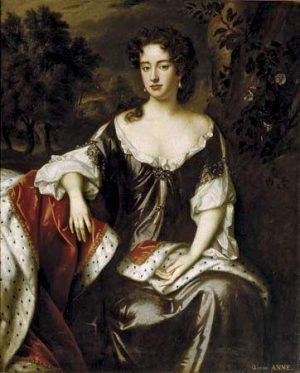Anne, Queen of Great Britain Death
Anne passed away on August 1, 1714 at the age of 49 in Kensington Palace, Middlesex, England, Great Britain.
When did Anne, Queen of Great Britain die?
August 1, 1714How old was Anne, Queen of Great Britain when died?
49Where did Anne, Queen of Great Britain die? What was the location of death?
Kensington Palace, Middlesex, England, Great Britain
Anne, Queen of Great Britain Birthday and Date of Death
Anne, Queen of Great Britain was born on February 6, 1665 and died on August 1, 1714. Anne was 49 years old at the time of death.
Birthday: February 6, 1665
Date of Death: August 1, 1714
Age at Death: 49
Is Anne, Queen of Great Britain's father, James II of England, dead or alive?
Anne, Queen of Great Britain's father, James II of England, died on September 16, 1701 as he was 67 years old.
Is Anne, Queen of Great Britain's mother, Anne Hyde, dead or alive?
Anne Hyde's information is not available now.
Anne, Queen of Great Britain's sister :
Anne, Queen of Great Britain's sister, Mary II of England, died on December 28, 1694 as he was 32 years old.
Anne, Queen of Great Britain - Biography
Anne ascended the thrones of England, Scotland and Ireland on 8 March 1702. On 1 May 1707, under the Act of Union, two of her realms, the kingdoms of England and Scotland, were united as a single sovereign state, the Kingdom of Great Britain.
Anne was born in the reign of her uncle Charles II, who had no legitimate children. Her father, Charles's younger brother James, was thus heir presumptive to the throne. James's suspected Roman Catholicism was unpopular in England, and on Charles's instructions Anne and her elder sister, Mary, were raised as Anglicans. On Charles's death in 1685, James succeeded to the throne, but just three years later he was deposed in the Glorious Revolution of 1688. Anne's sister and Dutch Protestant brother-in-law and cousin William III of Orange became joint monarchs. Although the sisters had been close, disagreements over Anne's finances, status and choice of acquaintances arose shortly after Mary's accession and they became estranged. William and Mary had no children. After Mary's death in 1694, William reigned alone until his own death in 1702, when Anne succeeded him.
Anne was unable to walk between January and July 1713. At Christmas, she was feverish, and lay unconscious for hours, which led to rumours of her impending death. She recovered, but was seriously ill again in March. By July, Anne had lost confidence in Harley; his secretary recorded that Anne told the cabinet "that he neglected all business; that he was seldom to be understood; that when he did explain himself, she could not depend upon the truth of what he said; that he never came to her at the time she appointed; that he often came drunk; [and] last, to crown all, he behaved himself towards her with ill manner, indecency and disrespect."
On 27 July 1714, during Parliament's summer recess, she dismissed Harley as Lord Treasurer. Despite failing health, which her doctors blamed on the emotional strain of matters of state, she attended two late-night cabinet meetings that failed to determine Harley's successor. A third meeting was cancelled when she became too ill to attend. She was rendered unable to speak by a stroke on 30 July 1714, the anniversary of Gloucester's death, and on the advice of the Privy Council handed the treasurer's staff of office to Whig grandee Charles Talbot, 1st Duke of Shrewsbury. She died around 7:30 a.m. on 1 August 1714. John Arbuthnot, one of her doctors, thought her death was a release from a life of ill-health and tragedy; he wrote to Jonathan Swift, "I believe sleep was never more welcome to a weary traveller than death was to her."








